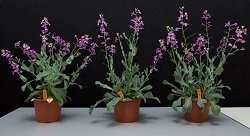The social networks of flowers

For centuries, people have conveyed feelings of happiness and love with flowers. Now an EU research team has found that plants flower more when surrounded by relatives compared to when growing with strangers or alone.
The EU-funded project KinCoop has investigated if natural selection can favour selfish or cooperative behaviour when it comes to flower production and reproduction. "We assessed how different social environments in terms of density and genetic relatedness may influence allocation of resources through the effect of sharing pollinators and the effect this will have on mating patterns and plant fitness," outlines Dr. Rubén Torices, a Marie Skłodowska-Curie fellow and lead project researcher. Plant fitness is simply reflected in its ability to reproduce successfully, and includes flowering and seed production after successful pollination.
30,000 seeds and 700 plants on trial
Project researchers first built a new model in collaboration with the University of St Andrews, Scotland, to demonstrate allocation of resources to reproduction depending on the type of plant neighbours. The model predicts that plants cooperate when surrounded by siblings and investment in flowers helps them compete against other groups of flowering plants.
In a controlled trial under glass using a close relative of the Brassicas to test this hypothesis, KinCoop scientists handled some 30,000 seeds and 700 plants. The researchers ascertained the extent to which plants invest in flowers to attract pollinators, a task made easier as Moricandia moricandioides has particularly attractive, conspicuous, purple flowers. A vast amount of data was collected on characteristics that attract pollinators, including petal size, floral colour and nectar secretion. Results have been published in the peer-reviewed journal Nature Communications.
Say it with flowers
KinCoop research results show for the first time that plants recognise kin and consequently modify their flowering strategies. "We found that plants invested disproportionally more resources to floral advertisement when they were growing with relatives compared to when they were growing with strangers or alone," says Dr. Torices.
Previous studies have shown kin recognition but only relating to root and shoot growth. KinCoop has moved from vegetative growth to reproduction and shown that plant social context may have deep consequences for plant reproductive phenotypes. Therefore, plant fitness may be highly influenced by social interactions between plants of the same species.
Challenges of working in plant ecology
"The biggest challenge we faced was the loss of a big outdoors experiment in spring when a plague of grasshoppers ate almost all the experimental plants just when they had started to bloom," explains Dr. Torices. Given the timing of the loss, the team will have to repeat the experiment for conclusive results.
"We need to modify the experimental design offering more protection against insect pests," points out Dr. Torices. This is in itself challenging because plants have to be protected from pests but at the same time visited by their natural pollinators, also insects.
Applying social theory to crop science
Repeating the lost experiment will be key to finding out whether this plant behaviour can be considered as altruistic, if there is a cost to the individual but a benefit to the group. "We want to know if plants cooperate in reproduction and what are the key ecological factors driving this behaviour in plants," explains Dr. Torices.
During the project, the KinCoop team organised a workshop attended by researchers from universities, agronomic centres, and companies from the agriculture sector on the use of social evolution theory in breeding programmes, crop improvement and pest management. Dr. Torices sums up: "In the future, we will continue with our commitment of disseminating the implementation of social evolution theory in the improvement of plant production."
More information: Rubén Torices et al. Kin discrimination allows plants to modify investment towards pollinator attraction, Nature Communications (2018). DOI: 10.1038/s41467-018-04378-3
Journal information: Nature Communications
Provided by CORDIS




















